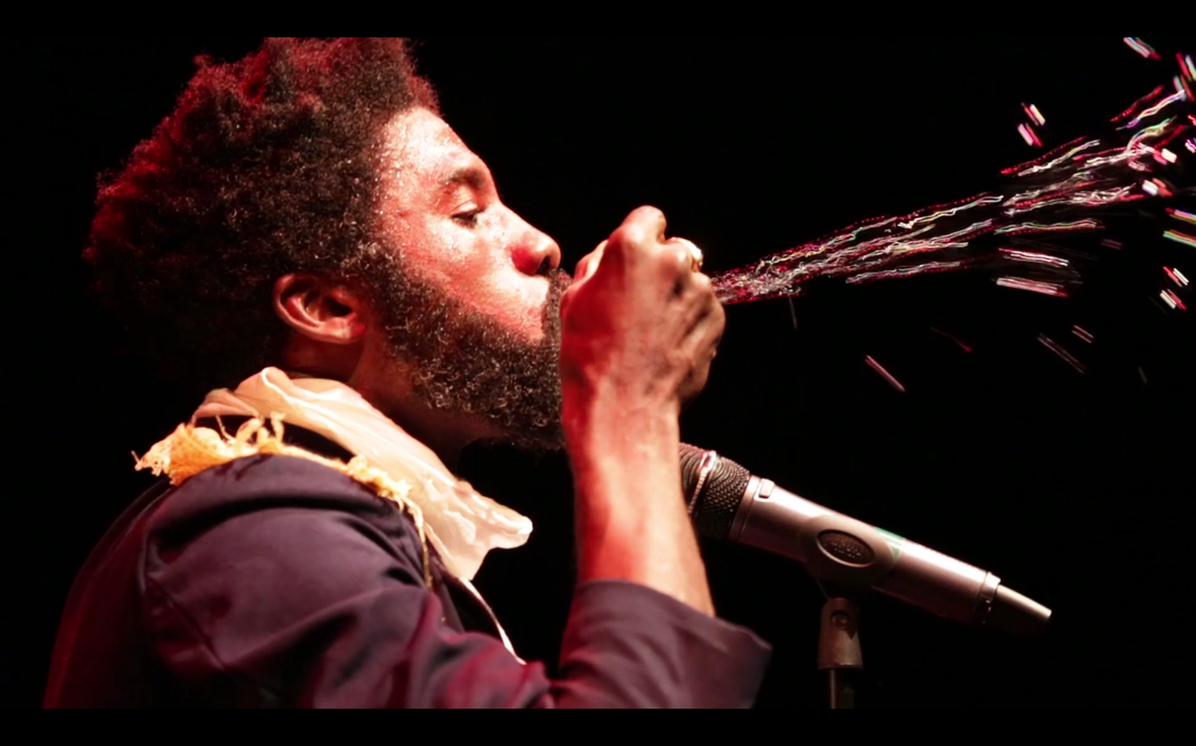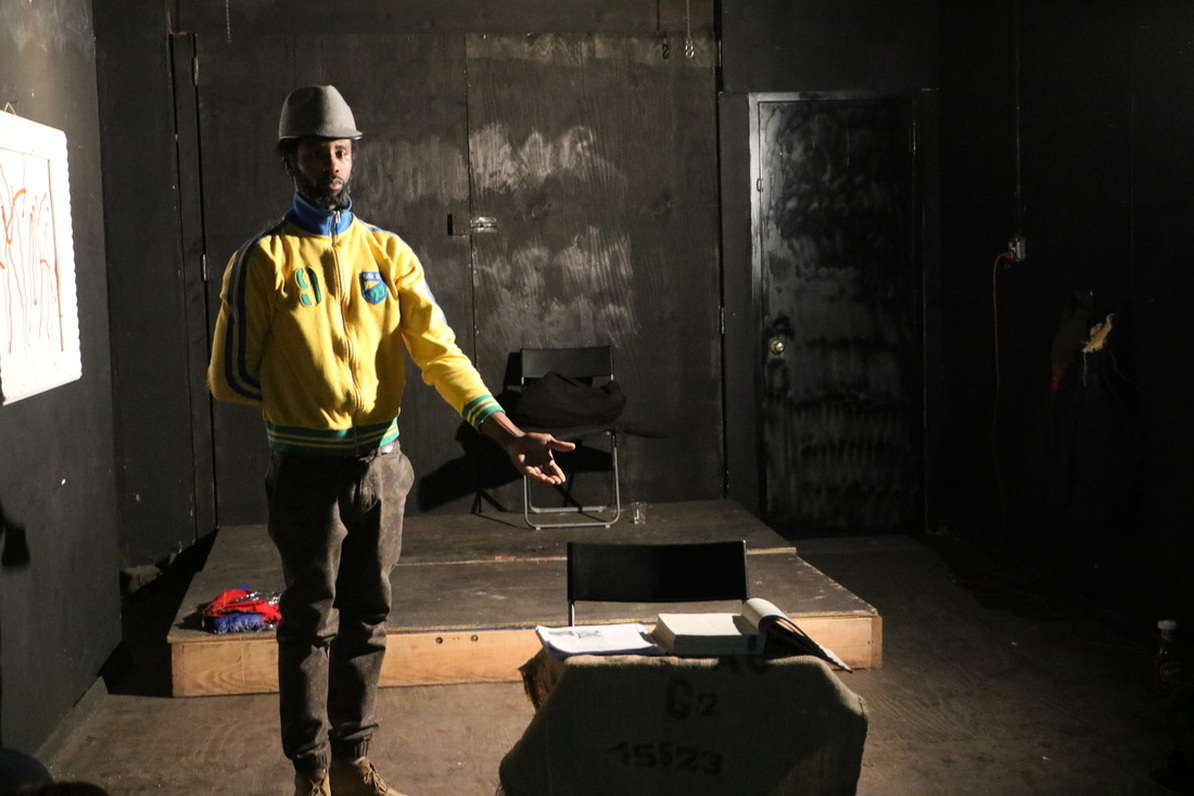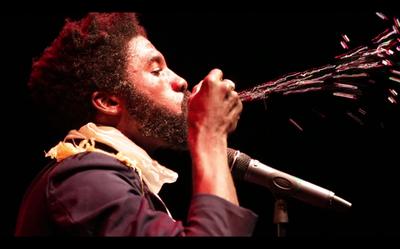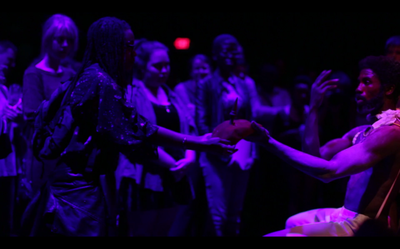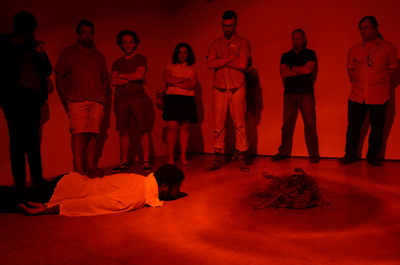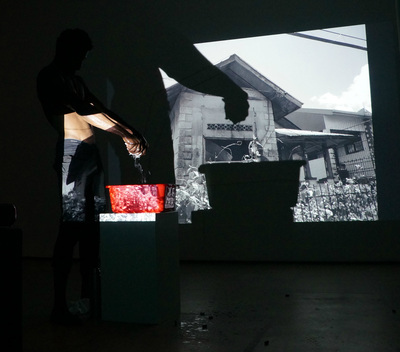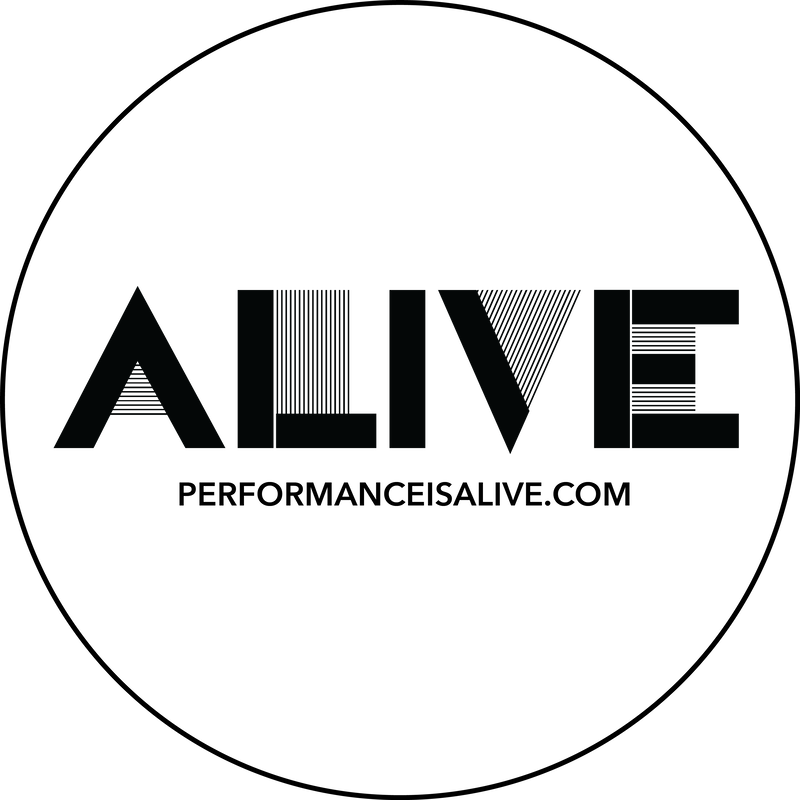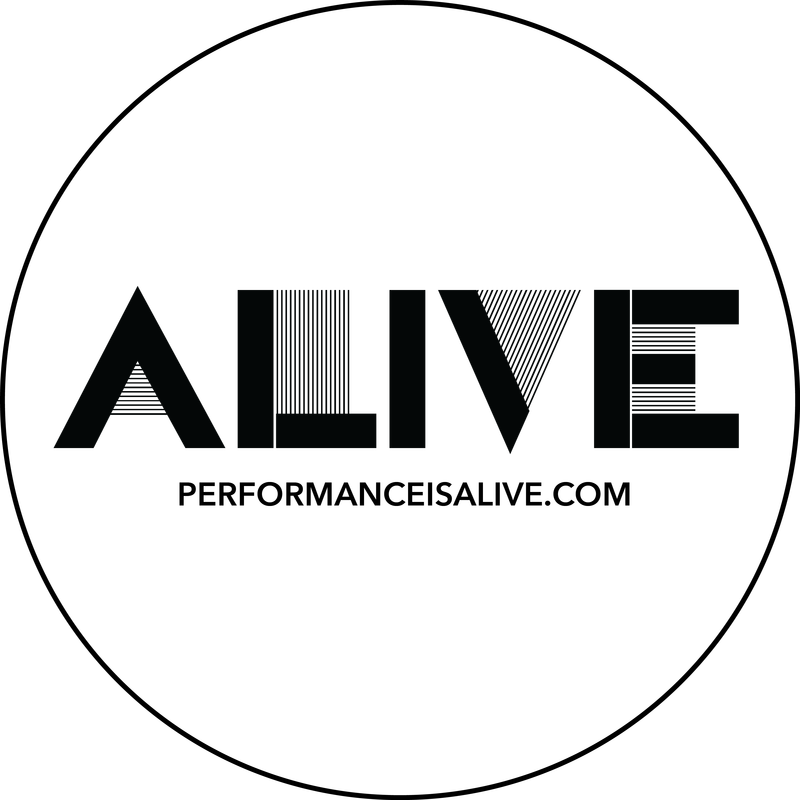|
Over the past 6 years, I've witnessed the ebb and flow New York's performance art community. Many performance artists who presented work in 2010 have left the discipline entirely due to high living costs and low (to no) performance honorariums. Fortunately, several performance artists have evolved their practice and successfully developed their careers through exhibitions, grants and awards. Multi-media artist, NYUGEN SMITH (NJ), is one such example and has established himself as a staple within the New York performance community. Smith was the first performance artist to cross my invisible "this-is-a-safe-distance-from-a-messy-performer" boundary. Adorned in a white wig and blue petticoat, Smith gnawed on sugar cane inches away from my face. Cane juice dripped freely while puffs of white baby powder flew around Vaudeville Park (Brooklyn, NY). The layered scent of cane juice and baby powder paired with Smith's unwavering gaze diluted the performer/viewer "stage." This experience changed my approach toward viewing. I'll never forget it! In our latest Artist Feature, Smith discusses intercepting boundaries while exploring the role of performer and viewer as director. Enjoy! - Quinn Dukes QUINN DUKES: Can you talk about your practice as a multimedia artist? Does one medium influence the other? NYUGEN SMITH: For me, working with various media allows for more opportunities to play. As ideas are generated, I go to the medium that I feel will allow me to communicate most effectively at that moment, for that particular project. I often speak about this fluidity in terms of spoken language-sometimes one needs to use another language to get closest to saying what needs to be said. It also comes from the the need to be able to make at any moment. One medium does influence the other in my practice. On a subconscious level, choices and actions are primarily made and cannot be separated from the sum of my experiences. On a conscious level, what is learned from, experienced, through one medium is intentionally utilized during the creative process. I ask myself, for example, how does what I know about lighting for on camera video performance inform lighting choices for live action? What have I learned from collage that can be useful in drawing and performance? QD: Do you often use your sculptural and/or collage objects within your performances? NS: Yes, I often include and use some of my sculptural objects in my performances. I often find that they reveal new meaning when activated in thin this way. QD: You are in the final stages of your MFA at the School of the Art Institute of Chicago, how has your work evolved from this experience? NS: So much can be said about the impact of my MFA studies at SAIC on the evolution of my practice. I definitely read a whole lot more. Assigned readings have led me to writers, thinkers, artists and others who have interesting things to say and ask important questions. QD: Who are some of these authors? NS: Authors such as Fred Moten, Malidoma Patrice Somé, André Schwarz-Bart, Robert Farris Thompson, Claudia Rankine, and Walter Benjamin, have been impactful. I read slowly, so teaching full-time in a high school and maintaining an active studio practice often left me with little time to read a lot. Since I began grad school, I slowed down on the amount of objects I have produced. The amount of reading and writing required for my courses naturally shifted me to spending more time with my head in the books than in the studio. The amount of performance work I have done has increased significantly during this period. It was a welcomed transition and I truly enjoyed it. Certain texts caused me to think about my work on other levels and also strengthened my ability to speak about my work within other contexts. My professors, studio mentors and classmates have also been inspirational and influential to my practice through their formal and informal critiques, suggested readings, art practices, and their writings. QD: What led to an increase in performance? NS: Being a part of Social Health Performance Club has played a significant role in increasing the visibility of my Performance work and has subsequently led to more requests and opportunities. During this time of study- being in my head more, has definitely strengthened the way I have developed in this art form. The School of the Art Institute of Chicago nominated me for the 2016 Leonore Annenberg Fellowship and I was one of nine artists to receive this national award. The fellowship will provide me with support to make my transition to working on my art full-time. QD: So, this is why you decided to leave your teaching position? NS: Yes. It was my dream, as with many artists, to be able to rise each day and tend to the business of their art practice. So, to honor this gift, to give it all that it requires of me, to make the most of this opportunity, stepping out of the classroom was necessary. QD: Your performance at Gallery Sensei (NYC) in May 2016, relied heavily on audience participation and audience member as performer. Can you discuss your intentions for participation in this particular work? NS: I'm glad to know that "audience member as performer" was evident. I am interested in developing some ideas where I am not a participant, but the director. The work at Gallery Sensei, was the second work where I experimented with "directing" as performance. The first was a work titled, iambic pentameter, made during an edition of Tif Robinette and Ian Deleón's PULSAR in Brooklyn, NY. That work was developed after reading Fred Moten's Resistance of the Object: Aunt Hester's Scream and reflecting on "(b)etween looking, being looked at, spectacle and spectatorship, enjoyment and being enjoyed..." This Moten text was shared with my by my studio mentor, Steffani Jemison after conversation and review of a previous performance. So, with this Moten text and directing - all swirling in my head, I developed the work presented at PULSAR and Gallery Sensei. My intentions for the participation were manifold. I am interested in what happens when an audience member - who volunteers to participate - is given a task to perform without any verbal or written instructions. I am directing the action involved in the task, however, essentially the volunteer cum performer can essentially take it in another direction if she/he chooses and. This can potentially shift the work dramatically and that becomes part of the permanent record of the piece. It's also about memory. How does the audience participation affect how I remember the work and how it is remembered by the audience? In the beginning of the performance I had them place a rope around themselves in the back room and drew everyone in very close- with me in the center before I blew the conch shell and drank a glass of wine. How did this action of bringing the group together in the beginning so closely affect their willingness to participate and empathize with those who volunteered during the rest of the performance? QD: Your last performance was void of any verbal communication yet incredibly directive. Has this method of guidance ever led to audience misinterpretation? NS: I'm not sure if there was any misinterpretation by the audience. I don't know how to measure this. There have been times when the participant did not understand my direction in the performance and did something other than what I intended for them to do. One thing that I have always stressed with my students is that there is always a way to use whatever it is that doesn't go as planned. Sometimes they can be used immediately and other times, just save them because they can be useful later. So, as these moments occur during the performance, I allow them to inform how the works develop. For example, during the performance at Gallery Sensei, the artist Ayana Evans volunteered to participate. I gave her the task of twirling an umbrella while holding it over her head. I intended to have three volunteers seated on the bench, but when I signaled to her (by licking my finger and drawing an invisible X) to sit on the bench, she stood on it. It immediately reminded me of something else I wanted to experiment with, a choir as part of a performance. So I signaled to the other volunteer to stand on the bench also and I began to conduct the two person choir. It was totally unexpected and was a beautiful transition to the part of the performance that followed. QD: Where does your interest in a performative choir stem from? NS: I just love the way the voice can move the mind, body and spirit. In my life I have spent a significant amount of time in Spiritual Baptist Churches in Trinidad, Catholic and Black and churches of different faiths the U. S. So I have experienced the performative act of using the voice for most of my life. I am interested in what voices working together can produce. QD: Your recent writings are like stream of consciousness word mappings tying together tangents of learned and lived histories. What is your intent with the performance writings? NS: In relation to my writings about my performances, then yes, I do look at these writings as a poetic written extension of the performances. In regards to my writing related to my photographs, social media posts, I see this writing as poetry. This is another way that my Grad program has had an impact on my work. Writing is central to our program. The poetics not only of language but in all that I make as an artist is important to me. I have had the honor and privilege of studying with, learning from, reading and collaborating with some brilliant artists/writers such as Sandrine Schaefer, Cheryl Pope, Julian Gato, Alissa Chanin in the last two years and this has had a huge impact on my writing style. For the majority of visiting artists in my MFA program including Glenn Ligon, Eileen Myles, Yvonne Rainer, Allejandro Sesarco, Lynn Tillman, writing is their medium or included as an important part of their practice. From 1994-2001, I wrote, recorded and performed spoken word poetry and rap music. So even before I devoted myself to the visual arts, writing poetry was a part of me. So much can be said by not saying much at all. When writing creatively, I think about using words sparingly. Language can be used to include and exclude. To open and to close. I think about opening my writing. Leaving room for breathing in what is being said, what is being implied, and what can be derived from the sum of absence and presence in my writing. QD: Do you have performance art mentors? NS: I don't have any performance art mentors per se. However, some people and institutions that have had an impact on my performance work recently are, Grace Exhibition Space (I've learned so much from the extensive list of brilliant artists who have made and continue to make performances here and are part of GES' projects), Hector Canonge, Sandrine Schaefer, Ian Deleón and Tif Robinette, Cheryl Pope, Clifford Owens, yon Tande, Steffani Jemison, Denenge Akpem, and Marilyn Arsem. There are others who I don't know personally and have never had a conversation with, but research their work to learn. QD: What do you think about the contemporary performance art community in Brooklyn versus Chicago? NS: I don't know the performance art community in Chicago. Since I have only spent a relatively short time there, I have not had the opportunity to truly become a part of that community there. There are some wonderful artists there that I know who are making great performance work. I've been in exhibitions with and have begun having conversations about working with performance artists from Chicago in the future. The community in Brooklyn is one that has encouraged and supported my growth as an artist who also works in performance. I have found that the community is thriving, growing and despite lack of critical reviews, limited inclusion in the programming and conversation surrounding performance at major institutions in NYC, the work continues. Thanks to platforms such as Performance is Alive, Incident magazine, PULSAR's Trouble Performing Podcast, Grace Exhibition Space, LiVEART.US (at the Queens Museum), artists who make performances in Brooklyn and surround area have spaces for to make work, have conversation, critical dialog, and build community. QD: What is next for you? Any upcoming exhibitions or performances to note? NS: A couple upcoming projects are confirmed: School of the Art Institute of Chicago MFA Thesis exhibition thru July 31st Sullivan Galleries, 33 S. State St., 7th floor Chicago, IL Yet to be titled Solo exhibition at Walsh Gallery at Seton Hall University Tuesday, September 6th – Friday, October 14th 400 S. Orange Ave South Orange NJ. October, Art in Odd Places 2016: RACE. Think High a Collaborative work with Thomas Powers More info to come: http://www.artinoddplaces.org/ Updates can be accessed on my website: http://www.nyugensmith.com/#!exhibits/yxir1 NYUGEN SMITH |
ABOUT nyugen smith | Drawing heavily on his West Indian heritage, Nyugen is committed to raising the consciousness of past and present political struggles through his practice which consists of sculpture, installation, video and performance. He is influenced by the conflation of African cultural practices and the residue of European colonial rule in the region. Responding to the legacy of this particular environment, Nyugen’s work considers imperialist practices of oppression, violence and ideological misnomers. While exposing audiences to concealed narratives that distort reality, he destabilizes constructed frameworks from which this conversation is often held. |
CONTRIBUTORS
Ian Deleón
Quinn Dukes
Alexandra Hammond
Luke Mannarino
Polina Riabova
Sarah G. Sharp
Alex Sullivan
Archives
July 2023
August 2022
November 2021
October 2021
September 2021
May 2021
March 2021
January 2021
December 2020
November 2020
September 2020
April 2020
January 2020
December 2019
November 2019
October 2019
September 2019
August 2019
July 2019
June 2019
April 2019
March 2019
February 2019
December 2018
November 2018
October 2018
September 2018
August 2018
July 2018
June 2018
May 2018
April 2018
March 2018
February 2018
January 2018
November 2017
October 2017
September 2017
July 2017
June 2017
May 2017
April 2017
March 2017
February 2017
January 2017
November 2016
September 2016
July 2016
June 2016
May 2016
April 2016
March 2016
February 2016
January 2016
December 2015
November 2015
October 2015
September 2015
August 2015
July 2015
June 2015
May 2015
April 2015
March 2015
February 2015
January 2015
December 2014
November 2014
